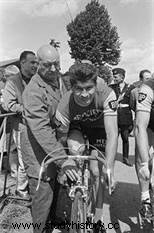 The Tour de France is the oldest and most famous cycling race in the world. It takes place every year in July for three weeks and traditionally ends on the Avenue des Champs-Élysées in Paris. The history of the Tour de France cyclist is a small part of the history of France in the 20th century. This mythical race of world renown is more than a century old, the first round having taken place in 1903. Let's come back to this unmissable event of the summer, attracting more and more people along the roads of France, despite the periods interrupted due to war. and despite the excesses and doping problems.
The Tour de France is the oldest and most famous cycling race in the world. It takes place every year in July for three weeks and traditionally ends on the Avenue des Champs-Élysées in Paris. The history of the Tour de France cyclist is a small part of the history of France in the 20th century. This mythical race of world renown is more than a century old, the first round having taken place in 1903. Let's come back to this unmissable event of the summer, attracting more and more people along the roads of France, despite the periods interrupted due to war. and despite the excesses and doping problems.
From the first bike race to the first Tour de France
The first race on a bicycle took place in May 1868 at the Parc de Saint Cloud in Paris over 1,200 meters; the following year the distance increases and passes to 123 kilometers; at the beginning of the 20th century, the races reached around 400 km like that of “Bordeaux-Paris” and were organized by two newspapers:Auto and Vélo. To make more prints and gain market share, Auto journalist Géo Lefèvre, imagines a grand tour of France, a road race in stages, "the greatest cycling event of all time" of 2,400 km then 5,300 kms in 1911 to currently return to 3,400 kms.
 He proposed his project to his director Henri Desgrange, a regular cyclist, tricycle champion in 1893, founder of the newspaper l'Auto in 1900, organizer of the Paris-Marseille race in 1902 and who initiated the 666 m cycle track at the Parc des Princes. Desgrange accepted and in November 1902 the Tour de France was born! From July 1 to 19, 1903, 60 runners set off from the outskirts of Villeneuve-Saint-Georges for six stages; the first stops in Lyon (467 kms), then the tour goes through Marseille, Toulouse, Bordeaux and Nantes in particular; only 21 runners finish at the Parc des Princes; the winner is French Maurice Garin after 2,428 kms!
He proposed his project to his director Henri Desgrange, a regular cyclist, tricycle champion in 1893, founder of the newspaper l'Auto in 1900, organizer of the Paris-Marseille race in 1902 and who initiated the 666 m cycle track at the Parc des Princes. Desgrange accepted and in November 1902 the Tour de France was born! From July 1 to 19, 1903, 60 runners set off from the outskirts of Villeneuve-Saint-Georges for six stages; the first stops in Lyon (467 kms), then the tour goes through Marseille, Toulouse, Bordeaux and Nantes in particular; only 21 runners finish at the Parc des Princes; the winner is French Maurice Garin after 2,428 kms!
It was not until 1905 that the mountain was added to the Tour de France route and the first "mountain stage" was the ascent of the Ballon d'Alsace. In 1910, to give a little more interest, an employee of Henri Desgrange then proposed to go through the Pyrenees and was answered by his boss “Cross them! You are crazy ! Passing cyclists on goat paths... Who will be insulted by the runners? It's me ! At this announcement, a few riders set out on reconnaissance, exclaiming "we will never be able to climb the top"... Of 150 riders at the start of the 1909 Tour, only 110 showed up in 1910. And the Alps were on the menu in 1911 .
 Since then, the Tour de France cyclist has always attracted as many people, despite the periods of war, despite the evolution , the public becoming more and more numerous along the roads as in 2002 when more than 100,000 people were present throughout the ascent of Mont Ventoux “the giant of Provence” and this, despite the 35°!
Since then, the Tour de France cyclist has always attracted as many people, despite the periods of war, despite the evolution , the public becoming more and more numerous along the roads as in 2002 when more than 100,000 people were present throughout the ascent of Mont Ventoux “the giant of Provence” and this, despite the 35°!
Mythical jerseys in the history of the Tour
Mark of the winner of the Tour, the yellow jersey was not created until 1919. During this tour, the Pélissier brothers retired on the fifth stage and Eugène Christophe took the lead but he is unknown to the public. In order to be noticed, he is made to wear a jersey of a distinct color, the organizers choosing yellow in honor of the newspaper l'Auto. It is customary not to put it on for a day, if its previous wearer has given up due to an accident. However during the 1954 tour, Louison Bobet who is first in the classification, does not wear his yellow jersey at the start of the Saint-Brieuc -Brest stage ... he offered it to his sister the day before! The organizers are panicking because it is impossible to let the runners leave without "the yellow jersey".
Raymond Le Bert, Bobet's healer remembers that he has one at his home and runs to get it. Except that by putting it on, Bobet is stuck and can't breathe:the jersey has shrunk....Fortunately, the trainer also runs a boxing gym in the city. He quickly summons one of his heavyweights, asking him to "widen" the jersey, it contorts so much so that he finally manages to put it on...the seams have come loose, the race can start, Louison Bobet is in yellow!
 A single distinctive jersey is no longer enough and on the occasion of the 50th anniversary of the Tour, the "green jersey" was inaugurated in 1953, rewarding the best sprinter. The “white jersey” was created in 1970, awarded to the young rider under 25 who was best placed in the general classification. Finally, it was not until 1975 that the best climber received for the first time a new "shirt with red polka dots on a white background".
A single distinctive jersey is no longer enough and on the occasion of the 50th anniversary of the Tour, the "green jersey" was inaugurated in 1953, rewarding the best sprinter. The “white jersey” was created in 1970, awarded to the young rider under 25 who was best placed in the general classification. Finally, it was not until 1975 that the best climber received for the first time a new "shirt with red polka dots on a white background".
Some Tour de France anecdotes
The Tour de France became the unmissable annual event, but it almost did not see the light of day in 1905. Indeed, the 1904 edition is remembered because of spectators who attacked certain runners and who threw nails on the road! Among the big accidents, we think of Eugène Christophe who fell in 1913, breaking his bicycle. He had to walk more than 15 km to find a blacksmith to carry out the repair.
Note that Henry Anglade had foreseen the serious fall of Roger Rivière in the 1960 Tour rendering him invalid; we cannot forget the sudden death of Tom Simpson in the ascent of Mont Ventoux in July 1967 due to the heat and the taking of amphetamines when an anti-doping law had just been adopted in 1966 nor that of the champion Italian Olympic Casartelli whose head hit a parapet violently in the Col du Portet d'Aspet in the Pyrenees in 1995 or the feat of the 1983 yellow jersey Pascal Simon with a fractured shoulder blade but who pedaled another 5 days to finally give up in tears at the Côte de la Chapelle; Eddy Merckx who reached the same record as Anquetil with his 5 yellow jerseys will not be able to obtain a 6th, having received a punch in the liver from a spectator favorable to another competitor in the 1974 round. ..
 In the "less catastrophic", it is said that during the first tours of France, some riders took the train to the long stages; in 1929 the radio broadcast the first transmission allowing to follow the stages and the newspaper which only appeared the next day lost value until the arrival of television reports in 1960; it was in 1930 that the first caravan of the tour passed on the route before the riders; after 8 years of absence, the tour resumed in 1947 under the direction of Jacques Goddet, editor of the newspaper l'Equipe; the same year, it is the Anquetil-Poulidor duel where in Paris, on the podium, the winner admits to the eternal second “What could have made me sweat, you, in this Tour!”; Anquetil, winner of the tour for the 5th time in 1964, did not hesitate one day to bother an Italian rider named Polidori who reminded him too much of his opponent Poulidor!...
In the "less catastrophic", it is said that during the first tours of France, some riders took the train to the long stages; in 1929 the radio broadcast the first transmission allowing to follow the stages and the newspaper which only appeared the next day lost value until the arrival of television reports in 1960; it was in 1930 that the first caravan of the tour passed on the route before the riders; after 8 years of absence, the tour resumed in 1947 under the direction of Jacques Goddet, editor of the newspaper l'Equipe; the same year, it is the Anquetil-Poulidor duel where in Paris, on the podium, the winner admits to the eternal second “What could have made me sweat, you, in this Tour!”; Anquetil, winner of the tour for the 5th time in 1964, did not hesitate one day to bother an Italian rider named Polidori who reminded him too much of his opponent Poulidor!...
Finally, to end on a happy note, let's mention a gifted but funny rider who made the public and the peloton laugh:Roger Hassenforder, nicknamed “the clown”. He started cycling in the 1950s, not hesitating to leave his regiment to participate in a race and often go back to the barracks with a cup. Yellow jersey from his first Tour de France, he won a lot of criteriums, pedaling like crazy, often riding upside down on his bike or stopping at café terraces to drink a beer while waiting for the rest of the peloton! Talkative, he talks as much as he pedals, a chatterbox! Flambeur, sometimes quarrelsome, he was suspended for 6 months in 1957 following an argument with Anquetil! A man that every former runner cannot forget!
In 2014, the Tour de France celebrated its 101st edition under the colors and cornflowers of the commemoration of the centenary of the First World War. The organizers and runners criss-crossed the roads of France in memory of the civilians and soldiers who fell during this war, through reconstructed landscapes that still bear the scars of the horrors of war.
To go further
- The great history of the Tour de France, by Françoise Laget, Serge Laget. Chronicle Editions, October 2012.
- The fabulous history of the Tour de France, by Pierre Chany and Thierry Cazeneuve. La Martiniere, 2011.
- History of the Tour de France, by Jean-François MIGNOT. Discovery, 2014.
